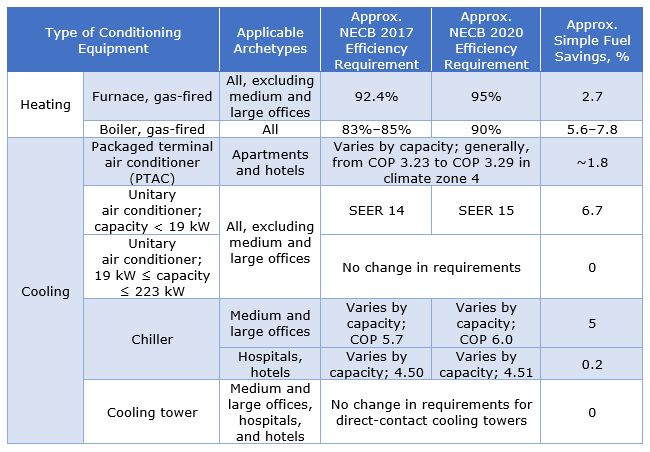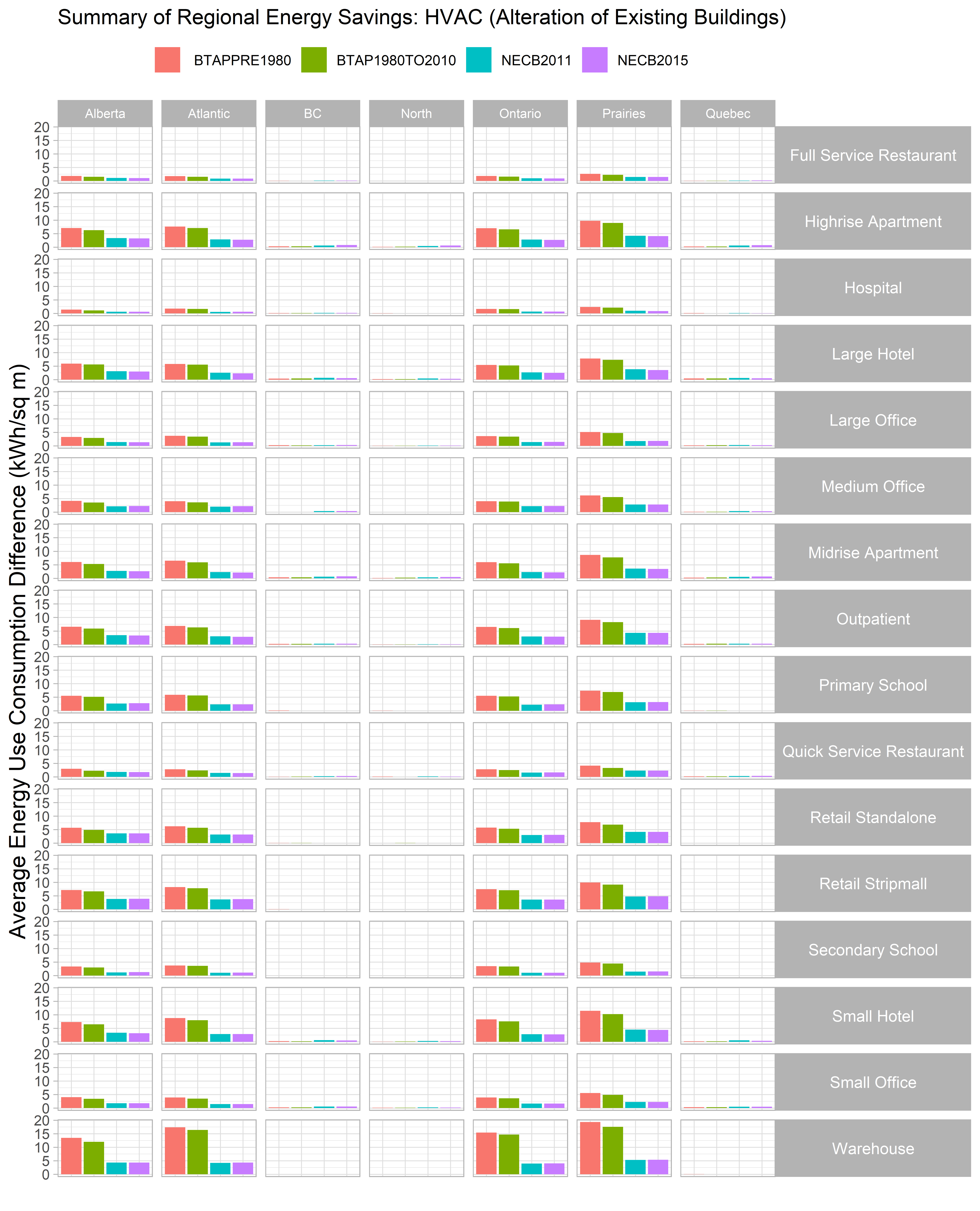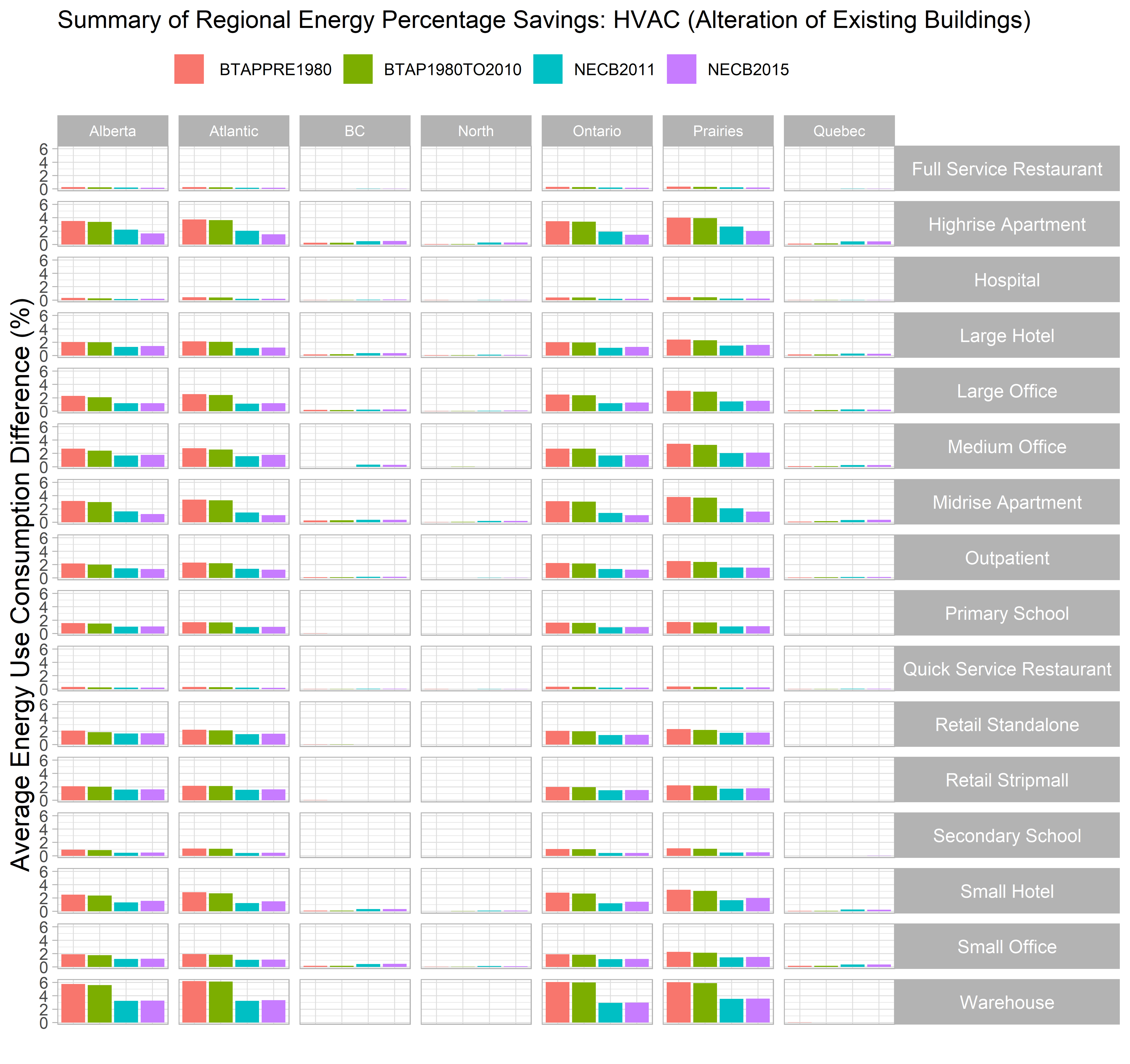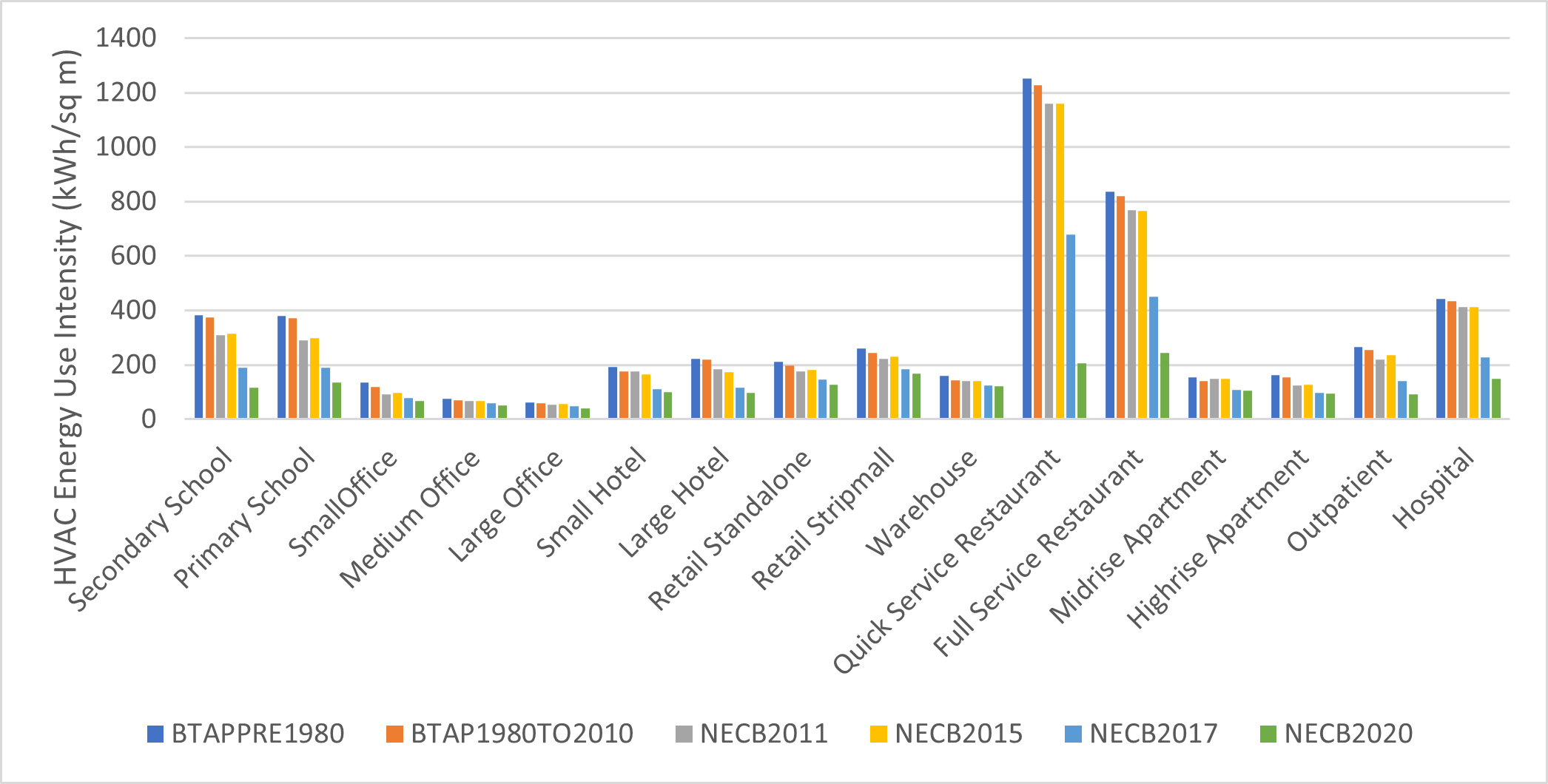NECB20 Div.B 13.5. (first printing)
General information
Problem
Heating, ventilating and air-conditioning (HVAC) systems in existing buildings can remain unaltered for the life of the system, which can be many decades in some instances. Older buildings that were built to meet the requirements of past editions of the Codes tend to consume more energy than their more modern counterparts.
The alteration of the existing building also provides a good opportunity to gradually upgrade the HVAC system and any ancillary components to meet current Code requirements. However, since renovation works in existing buildings are typically more costly than when building new constructions, the requirements of NECB Part 5 applicable to these upgrades must be adapted to maintain an acceptable level of cost-effectiveness.
Justification
HVAC systems comprise different components and subsystems that are integrated and interconnected to operate as a whole. Furthermore, the design requirements for a component, subsystem or an entire HVAC system can have a cascading impact on others. NECB Part 5 reflects that complexity by providing requirements that target each component and subsystem that can also have a cascading impact. The application of these requirements to systems in existing buildings must be carefully measured to ensure a reasonable cost-effectiveness.
Consequently, Part 5 requirements have been considered for full application to
- new standalone installations or additions within existing buildings, as these can be easily designed to different requirements than the rest of the building’s HVAC systems, and
- the entire scope of any alteration works.
The rest of the existing HVAC systems subject to alteration (i.e., those parts that are not affected by the initial scope of the alteration) are generally exempt because of the high cost of the related and cascading effects between components and systems that can be incurred. A few common upgrades generally considered to be cost-effective by the industry are still required.
However, when the proposed alteration work involves a significant change to the characteristics of a system (represented by a significant change in the thermal capacity of a system or in the layout of an air or water distribution system), it is deemed cost-effective in the long term for these systems to comply with all Part 5 requirements.
The threshold to determine what constitutes a “significant change” was set at 60%, as works of this magnitude generally and naturally have a significant cascading impact on existing systems, subsystems and associated systems, which require additional extensive modifications to maintain interoperability. Expanding these works to subject the entire HVAC system to the Part 5 requirements is considered cost-effective in these conditions.
PROPOSED CHANGE
[5.1.1.2.] 5.1.1.2.Application
[13.5.] -- Heating, Ventilating and Air-conditioning Systems
[13.5.1.] -- General
[13.5.1.1.] ---Scope
[13.5.1.2.] ---Application
[13.5.2.] -- Compliance
[13.5.2.1.] ---Requirements
Note A-13.5.2.1.(3) Criteria for Upgrading Existing HVAC Systems.
Impact analysis
The impact analysis guidelines for the alteration of existing buildings require that the proposed changes be evaluated for several building vintages. The key metric of interest in the impact analysis is the marginal difference between the current market practice and the proposed changes.
Since the prescriptive requirements for the alteration of existing buildings are triggered only when alterations are performed, the metric to evaluate the impact of these requirements is defined as the comparison between the new prescriptive requirements and what would normally be done in the absence of such (i.e., current market practice).
For this analysis, four vintages of unaltered buildings were selected:
- Pre-1980
- 1980–2010
- NECB 2011
- NECB 2015
Current market practice is defined as complying with NECB 2017, and the proposed code is considered to be the NECB 2020.
To calculate the marginal energy increment, a model representing the vintage was created (see https://github.com/NREL/openstudio-standards/tree/master/lib/openstudio-standards/standards/necb). The HVAC systems were then updated in the model to comply with the NECB 2017 requirements and the thermal energy use intensity (TEUI) calculated. The same process was followed for the NECB 2020 requirements. The marginal energy increment is the difference between these two TEUIs. This process was repeated for all the vintages for 16 archetypes in 32 locations across Canada (and later collated by region).
The primary driver of energy savings is the increased equipment efficiency from the NECB 2017 to the NECB 2020; few other differences exist (e.g., duct insulation), and their impact is negligible because they are not modeled or are narrow in scope (e.g., conditions applying to variable-air-volume systems only). The archetypes examined in this study use a range of HVAC systems. Table 1 presents the heating and cooling equipment used and their efficiencies as modeled in NECB 2017 (i.e., current practice) and in NECB 2020 (i.e., proposed code); fuel savings for each type of equipment is also estimated (i.e., how much less fuel is required).
NOTE:
- Table 1 only highlights relevant equipment efficiencies; the efficiencies related to auxiliary equipment (e.g., energy recovery ventilators, fans, pumps) were assumed to be constant and are not shown.
- Efficiencies are based on individual equipment capacities, and the values in Table 1 are representative of the class of equipment in the archetypes.
Table 1. Differences in HVAC Equipment Efficiency by Archetype

Summary results from the simulations are presented by region in Figures 1 (TEUI reduction) and 2 (percentage reduction); positive values indicate energy savings.

Figure 1. Marginal energy use intensity increment for various building archetypes and vintages in regions across Canada

Figure 2. Marginal percentage energy use intensity increment for various building archetypes and vintages in regions across Canada
Energy savings in British Columbia (BC), the North and Quebec are limited and are entirely attributed to cooling equipment because the archetypes assume electrical heating for those locations and there are no changes in electrical heating efficiencies (~100%). The cooling savings are minor because
- package terminal air conditioners are only used in dwelling spaces (apartments and hotels), the increased efficiency results in minor fuel savings (1.8%), and there is less energy reduction because total energy consumption is limited by the small capacities of the units;
- unitary air conditioning efficiencies have largely remained unchanged, except for smaller capacity systems (< 19 kW) that are used in archetypes with smaller energy consumption;
- Large capacity chillers (with 5% fuel savings) are limited to medium and large offices, and chillers with lower capacities have a negligible increase in efficiency (in hospitals and hotels);
- Cooling energy generally constitutes a small portion of the overall consumption for most buildings in Canada.
Conversely, energy savings for archetypes in Alberta, Atlantic Canada, Ontario and the Prairies are around 2% or higher, as shown in Figure 2. This is the result of increased energy efficiencies of the gas-fired heating equipment in addition to the cooling energy savings previously discussed. Heating energy savings are higher because
- heating constitutes a much larger portion of the overall energy consumption of buildings in Canada, therefore, increased energy efficiencies of these equipment have a larger impact, and
- gas-fired boilers had an appreciable increase in efficiency and are modeled in all archetypes.
Over time, the HVAC energy consumption of buildings decreases as newer equipment efficiencies are required. Figure 3 presents the average HVAC (including ERVs, fans and pumps) energy consumption of each archetype by vintage, indicating a decreasing trend over time. Note that to provide more neutral datum to demonstrate the trend of HVAC performance, a 1.5 L/(s×m2) at 75 Pa air leakage rate (as specified in Article 8.4.3.3. of Division B of the NECB 2020) was assumed for each archetype, regardless of vintage. Although this assumed air leakage rate provides a lower estimate of HVAC energy consumption in older vintages (i.e., energy consumption should be higher in older vintages), it provides a more conservative trend in declining energy consumption over time. Similarly, the differences in high-rise and midrise ventilation requirements between the NECB 2020 (ASHRAE 62.1-2016, "Ventilation and Acceptable Indoor Air Quality") and older vintages (ASHRAE 62-2001, "Ventilation for Acceptable Indoor Air Quality") were neutralized as well to demonstrate the performance of the HVAC independent of the differences in the ventilation loads of the dwelling spaces.

Figure 3. HVAC energy use intensity for various Canadian archetypes and vintages
Enforcement implications
The requirements for the alteration of HVAC systems in existing buildings could be enforced by the same means and resources involved in the enforcement of the prescriptive requirements of Part 5 of the NECB.
Who is affected
Designers, specification writers, manufacturers, contractors, building owners and building officials.
OBJECTIVE-BASED ANALYSIS OF NEW OR CHANGED PROVISIONS
- Date modified:
